Crispy Coconut Curry Chicken Thighs are packed with flavor, easy to make, and incredibly satisfying. This recipe combines creamy coconut milk, warm curry spices, and perfectly crispy chicken thighs.
Whether you’re hosting guests or cooking a comforting meal for yourself, this dish delivers bold flavor in every bite. The steps are simple, even for beginners—try it once, and it’s sure to become a regular in your kitchen!
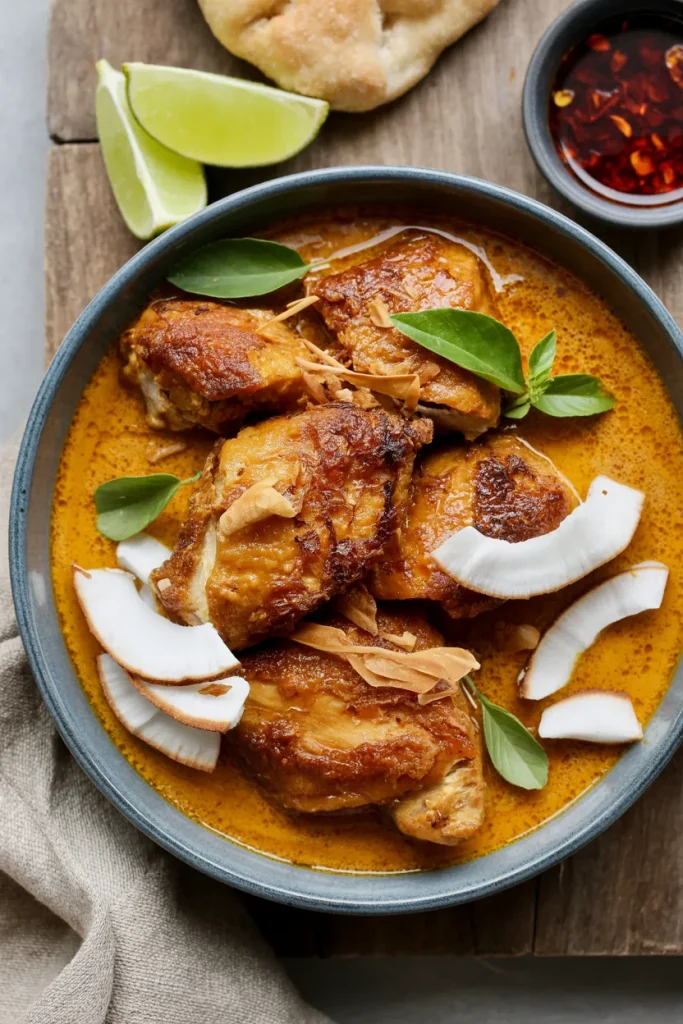
Nutritional Information
Here’s the breakdown for one serving (1 chicken thigh with sauce):
- Calories: 320
- Protein: 24g
- Fat: 22g
- Carbohydrates: 4g
- Fiber: 1g
These values are approximate and may vary depending on specific brands and substitutions used.
Ingredients You’ll Need
Here’s a rundown of the ingredients required for this dish, with some notes on substitutions to make it work for every kitchen.
Main Ingredients
- Chicken thighs (bone-in, skin-on): 6 pieces. The skin-on thighs crisp up beautifully, locking in moisture.
- Coconut milk: 1 cup (use full-fat for richer flavor; lite coconut milk works for a lighter option).
- Curry powder: 2 tablespoons (opt for a mild or hot blend depending on your spice preference).
- Garlic: 3 cloves, minced (fresh is best, but garlic paste works in a pinch).
- Ginger: 1 tablespoon, grated (swap with ½ teaspoon ground ginger if needed).
- Shallots: 2, finely chopped (can be substituted with a small onion).
- Turmeric powder: 1 teaspoon (adds both color and earthy depth).
- Paprika: 1 teaspoon (smoked paprika works well for a smoky undertone).
- Lime juice: 1 tablespoon (fresh juice for zesty brightness).
- Fresh cilantro (optional): For garnish.
Additional Ingredients
- Olive oil or coconut oil: 2 tablespoons for searing.
- Salt and pepper: To taste.
- Optional red chili flakes: ½ teaspoon for extra heat.
Most of these ingredients are pantry staples in a spice-lovers kitchen, but rest assured, any missing ingredients can be easily found at your local store or substituted as suggested above.
Step-By-Step Instructions
Follow these simple steps to create Crispy Coconut Curry Chicken Thighs that taste as amazing as they sound.
Step 1: Season the Chicken
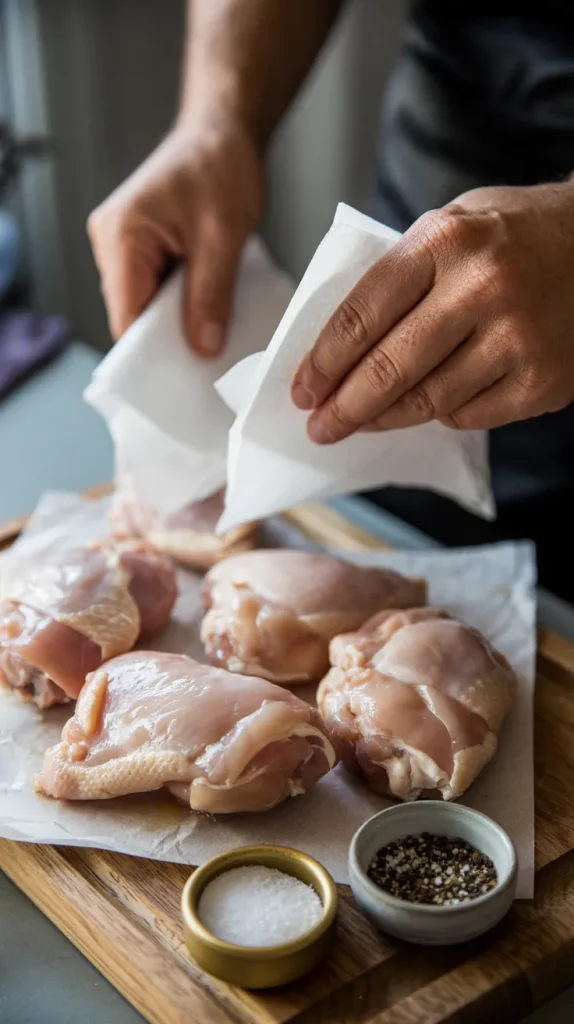
- Pat the chicken thighs dry with paper towels. (This is key for crispiness!)
- Generously sprinkle both sides with salt and pepper and set aside.
Step 2: Sear the Chicken
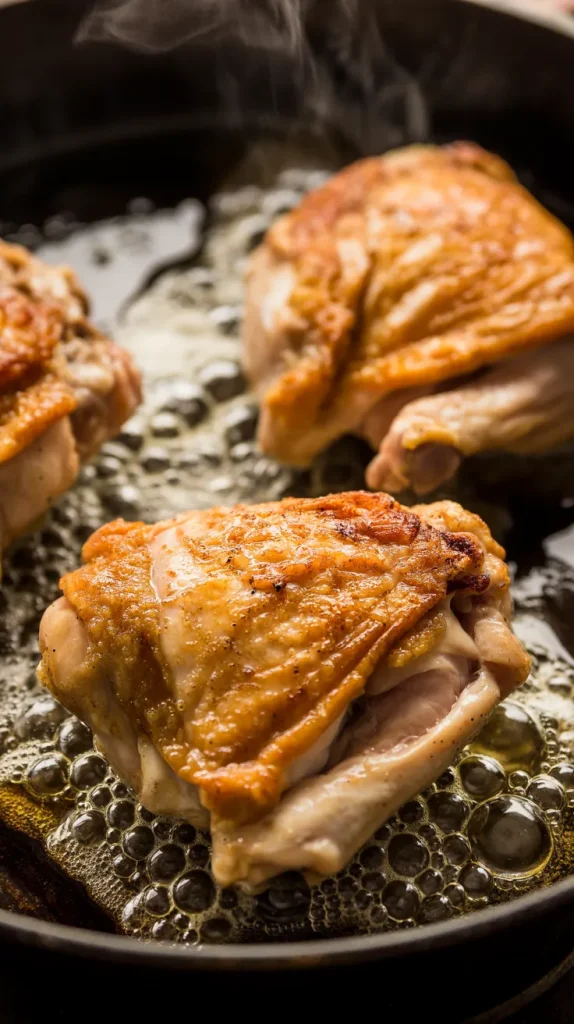
- Heat 2 tablespoons of olive oil or coconut oil in a large skillet over medium-high heat.
- Place the chicken thighs skin-side down. Cook for 7–9 minutes without moving to achieve golden, crispy skin.
- Flip the chicken and sear the other side for another 3–4 minutes until lightly browned. Remove the chicken and set aside (it will finish cooking later).
Step 3: Sauté Aromatics
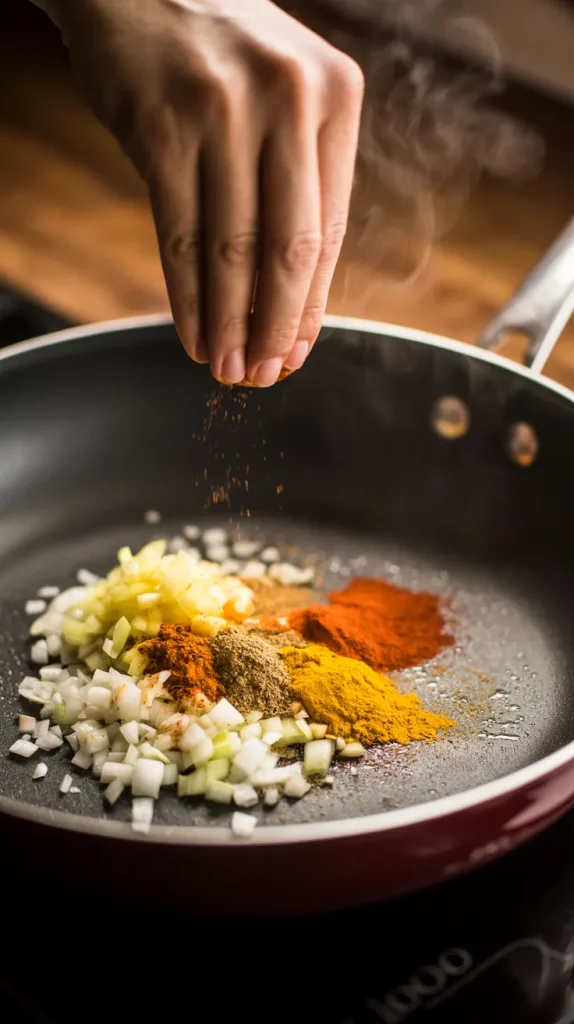
- Lower the heat to medium. Add the chopped shallots, garlic, and ginger and sauté until fragrant (2–3 minutes).
- Stir in the curry powder, turmeric, and paprika. Cook for 1–2 minutes to toast the spices and release their flavors.
Step 4: Add Coconut Milk
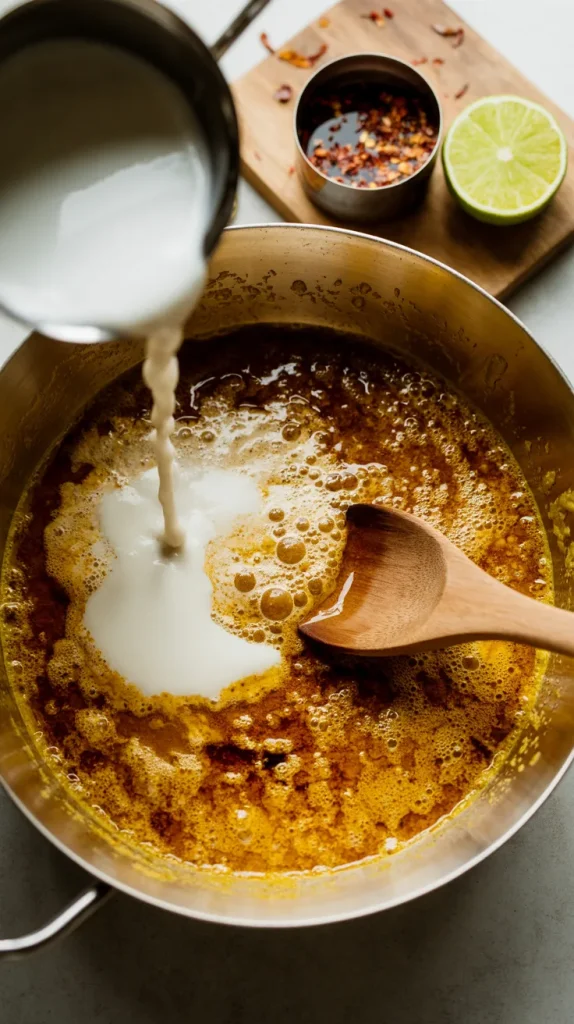
- Pour in the cup of coconut milk and stir well, scraping any caramelized bits off the bottom of the pan (that’s where the flavor is!).
- Add in lime juice and a pinch of red chili flakes (if using).
Step 5: Simmer with the Chicken

- Return the seared chicken thighs to the skillet, skin-side up. Spoon some sauce over the top.
- Reduce the heat to low, cover the skillet, and simmer for 20–25 minutes, or until the chicken is fully cooked (internal temperature of 165°F).
Step 6: Crisp in the Oven (Optional)

- For extra crispy skin, transfer the chicken to a baking dish and broil for 3–5 minutes. Watch closely to avoid burning.
Step 7: Serve & Garnish
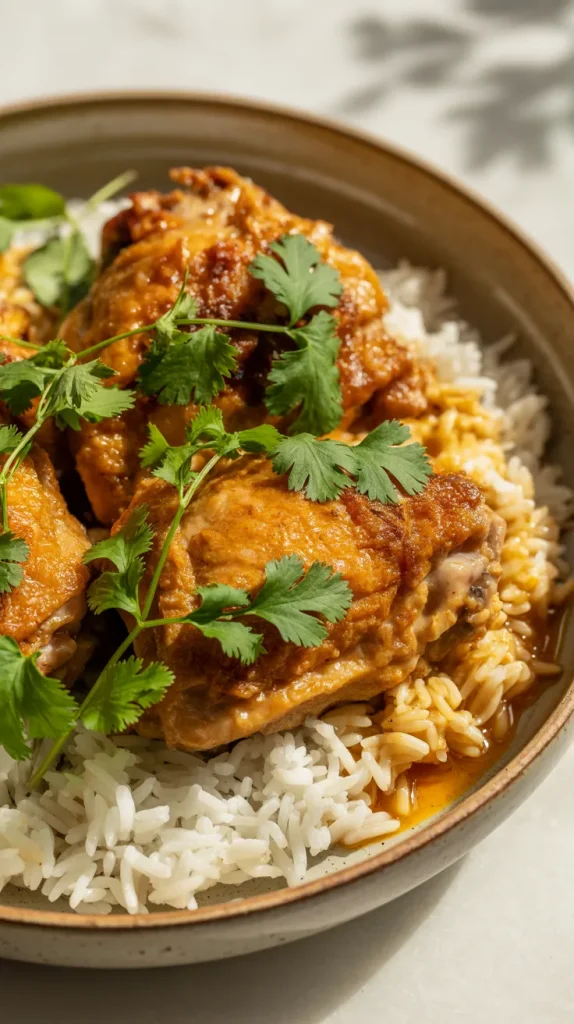
- Once done, garnish with fresh cilantro and serve immediately.
Tips & Tricks for Perfection
- Pat Dry for Crispiness: Always pat the chicken thighs dry before seasoning and searing. This ensures a golden, crispy skin.
- Don’t Rush the Sear: Resist the urge to move the chicken while searing. The skin will release naturally once it’s crisp enough.
- Use Full-Fat Coconut Milk: For a richer, creamier sauce, full-fat coconut milk is ideal. Lite versions may thin out the sauce.
- Adjust Spice Levels: Add more curry powder or chili flakes if you prefer a spicier kick.
Customize and Enhance the Dish
One of the greatest advantages of coconut curry chicken thighs is their incredible versatility. The recipe serves as a perfect canvas for personalization based on your preferences and what’s available in your kitchen.
Add vegetables like broccoli or spinach.
Vegetables not only enhance the nutritional profile of your coconut chicken thighs but also add color, texture, and flavor. Essentially, the dish welcomes almost any vegetable you have on hand:
- Quick-cooking options: Add fresh broccoli florets, baby spinach, snow peas, or bell peppers during the last 3-5 minutes of cooking. Spinach only needs the residual heat to wilt properly.
- Heartier vegetables: Carrots, cauliflower, and green beans should be added earlier, generally when you return the chicken to the pot, n—allowing 8-10 minutes to soften.
- Mushrooms: Cremini or button mushrooms pair beautifully with the creamy coconut curry chicken, adding earthy depth.
Adjust the spice level to your taste.
The beauty of homemade curry chicken thighs with coconut milk lies in controlling the heat to suit your preference:
For milder curry, remove seeds from chilies before adding them or reduce the curry paste amount. If your dish is already too spicy, add more coconut milk, though full-fat works best to maintain richness without watering down flavors.
Above all, for those seeking more heat, incorporate:
- A drizzle of Sriracha
- Jalapeño seeds
- Crushed red pepper flakes
- A pinch of cayenne (omit completely for mild versions)
Use lime juice or fish sauce for balance
At this point, fine-tuning the flavor balance transforms good creamy coconut curry chicken into exceptional curry:
Fresh lime juice brightens the entire dish, cutting through the richness of coconut milk. Start with a tablespoon, then adjust according to taste.
Fish sauce may seem unusual if you’re unfamiliar with it, nevertheless, even a teaspoon adds incredible depth and complexity without tasting fishy. It enhances the umami dimension, creating perfect harmony with other flavors.
Remember that curry balances five key flavors: sweet, sour, salty, bitter, and umami. If your coconut curry chicken thighs taste flat, add lime juice for sourness, fish sauce for umami, or a pinch of sugar for sweetness until everything tastes harmonious.
Serving Suggestions
Pair your Crispy Coconut Curry Chicken Thighs with these simple yet complementary options for a complete meal:
- Steamed Jasmine Rice: The perfect base to soak up the flavorful curry sauce.
- Garlic Naan Bread: Ideal for dipping into the rich coconut curry.
- Roasted Vegetables: Think carrots, bell peppers, or zucchini for a nutritious boost.
- Cucumber Salad: A refreshing, cool side to balance out the warm spices.
Bring Bold Flavors to Your Table
Crispy Coconut Curry Chicken Thighs are a perfect example of how simple ingredients can come together to create a bold, flavorful dish that feels both laid-back and elevated. It requires minimal prep but delivers maximum flavor, making it ideal for weeknight dinners or special occasions alike.
Now, it’s your turn to get cooking! Gather your ingredients, follow this guide, and take your taste buds on a delicious culinary adventure. Don’t forget to share your creations on social media using #CrispyCurryThighs—we’d love to see your masterpieces.
FAQs
Q1. What makes chicken thighs the best choice for coconut curry? Chicken thighs are ideal for coconut curry due to their higher fat content and natural tenderness. They remain juicy throughout cooking, resist drying out, and absorb flavors beautifully, resulting in a richer and more flavorful dish.
Q2. How can I ensure my chicken skin stays crispy in the curry? To maintain crispy skin, sear the chicken thighs skin-side down first, then simmer them in the curry sauce skin-side up. Importantly, avoid covering the pan while simmering to prevent steam from making the skin soggy.
Q3. What’s the secret to a flavorful curry base? The key to a flavorful curry base is sautéing onions, garlic, and ginger first, then adding and “blooming” the spices in oil before incorporating the coconut milk. This process builds layers of flavor and releases the essential oils in the spices.
Q4. Can I customize the spice level of my coconut curry chicken? Absolutely! You can adjust the spice level by varying the amount of curry paste or powder used. For more heat, add chili flakes or fresh chilies. To reduce spiciness, use less curry paste or add more coconut milk to balance the heat.
Q5. How long can I store leftover coconut curry chicken, and can it be frozen? Leftover coconut curry chicken can be refrigerated for 3-5 days in an airtight container. It also freezes well for up to three months. When freezing, consider concentrating the sauce slightly, as you can add liquid when reheating to refresh the texture.

